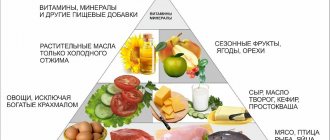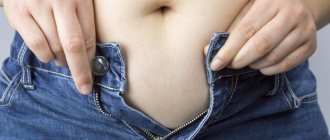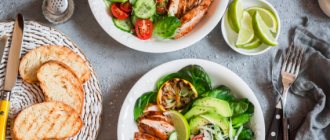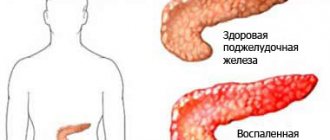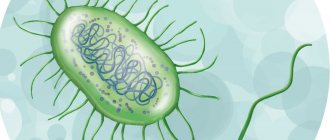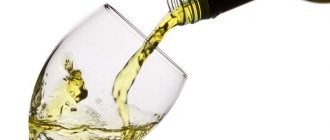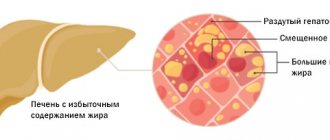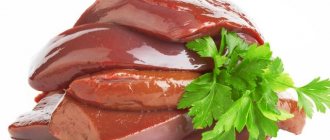Is it possible to lose weight on your favorite foods? Anything is possible in summer! Read more about delicious diets in the article.
When, if not in the summer, should you start taking care of your own weight? The holiday period and beach season encourage everyone who neglected healthy eating during the holidays to take more serious care of their body.
Summer diets are considered one of the easiest, both physically and psychologically, and there are a variety of menu options, so everyone can find a way to lose weight to their liking. Most often, excess weight is lost within a week, and during this time you can get rid of 5-7 kg without much difficulty.
What is liver fibrosis?
Liver fibrosis is a dynamic process during which the liver, in response to cell death due to inflammation, gradually increases the amount of connective tissue.
A healthy liver contains a small amount of connective tissue, which plays an important role in the formation of the complex structure of the organ. It surrounds the branches of the hepatic veins and arteries, the bile ducts and is located in the free space between the hepatocytes (the main cells of the liver) and the walls of the smallest hepatic vessels - the sinusoids.
Under the influence of various damaging factors, inflammation develops in the liver and hepatocytes die. Their death causes the production of substances that activate some of the connective tissue cells of the liver and, in particular, stellate cells, and they begin to produce collagen and other components of connective tissue.
During normal liver function, the process of producing additional connective tissue is aimed at maintaining its structure after voids form in the place of dead hepatocytes. In parallel, the process of restoration (regeneration) of cells starts in the liver, they increase in size for division, and the reverse mechanism of resorption of excess collagen under the influence of special enzymes is launched, and if the liver restoration process is successful, then it is freed from excess fibrous tissue.
But with chronic inflammation, the liver restoration process is disrupted. Excess connective tissue accumulates around larger hepatic vessels, bile ducts and in the free space between hepatocytes and the walls of small hepatic vessels - sinusoids. Fibrous tissue distorts the structure of the liver, disrupting its blood circulation and the passage of bile. Over time, the amount of connective tissue increases by 6-10 times compared to normal values, and more and more areas of the liver appear, replaced by connective tissue and unable to perform their functions.
Fibrosis can develop in various liver diseases:
- viral hepatitis B and C;
- non-alcoholic fatty liver disease (fatty hepatosis);
- alcoholic liver disease;
- autoimmune hepatitis
- hereditary disorders of iron and copper metabolism;
- drug or toxic liver damage;
- primary biliary cholangitis and primary sclerosing cholangitis and other rare diseases.
Despite the different nature of inflammation, the processes of formation of connective tissue occurring in the liver in all its diseases occur according to the same scenario. Read more about the causes of fibrotic changes and their prevention in our article.
Summer diets for weight loss are effective. What is a summer diet for weight loss?
It would seem that there is nothing simpler than eating healthy low-calorie foods for weight loss in the summer, because nature itself creates favorable conditions for the fight against excess weight. However, not everything is so simple, and even when following a light summer diet for weight loss, you must follow a number of rules so as not to harm your body. What is the summer diet and how to follow it correctly to get the best results?
To get the best results while following a diet, it is necessary to develop a certain system of proper and healthy nutrition. The following important nutritional principles must be taken into account when following the summer diet menu; they will help you lose weight without any problems. They look like this:
- Every day you need to drink at least 2.5 liters of ordinary clean water;
- before each meal you should drink a glass of water (30 minutes before);
- Every day you need to eat 500 g of fresh vegetables and fruits;
- the last meal should take place before 19:00;
- During the entire period of following a light summer diet, it is necessary to exclude the consumption of alcohol, and after the end, it should be limited;
- the daily calorie content of the menu should not exceed 1200 kcal;
- in addition to fresh vegetables and fruits, the menu should contain protein foods, and it is best if it is lean fish, legumes, poultry and seafood;
- It is prohibited to consume smoked, salty foods and various marinades, sweets, flour and confectionery products.
In addition, effective summer diets for weight loss should be complemented by regular physical activity, you must play sports, spend more time in nature, and go hiking.
By adhering to the above principles of a simple summer diet, you can lose 3-4 kg in a month. In cases where more impressive and faster results are needed, it is necessary to give preference to more rigid power systems.
Degrees (stages) of fibrosis
Liver fibrosis develops gradually over many years and sometimes decades. Its rate is influenced by both the activity of the underlying liver disease and the individual characteristics of the person, as well as the presence of additional damaging factors. To classify fibrosis, special scales can be used and, in particular, the METAVIR scale, which distinguishes five degrees (stages) of liver fibrosis, reflecting the degree of changes occurring and the possibility of reversibility of the processes:
F0 – healthy liver.
F1 - first degree , when excess fibrous tissue is located only around the branches of the hepatic artery and vein, located in special areas called portal tracts, without the formation of partitions (septa). At this stage there are usually no symptoms, and liver enzymes may also be normal. On a survey ultrasound of the liver, changes in its tissues are most often not detected; less often, an increase in the size of the organ is noted - hepatomegaly and the presence of structural heterogeneity (this study cannot determine the stage of fibrosis).
F2 – second degree , in which additional septa are formed from fibrous tissue, isolating the main liver cells (hepatocytes) from the blood entering the liver. This disrupts the process of blood purification by hepatocytes and prevents the entry of substances that these cells produce into the blood. In places where septa are formed, blood bypasses the liver cells and is discharged from the afferent vessels into the hepatic veins. In most cases, there are no symptoms at this stage either. Liver enzymes and inflammatory markers increase; liver ultrasound in all patients shows an increase in the size of the organ and the presence of structural heterogeneity.
F3 – the third degree occurs 6-8 or more years from the onset of the disease. The number of septa and fibrous tissue in the portal tracts increases significantly. Usually at this stage the first symptoms appear - weakness, drowsiness, fatigue, bruises on the skin and others. Liver enzymes increase, hemoglobin and platelet levels decrease, inflammatory markers increase, and on liver ultrasound, the presence of denser areas is added to liver enlargement and diffuse changes. Up to the third stage, fibrotic changes in the liver can be reversible with complete cure of the disease that caused them.
F4 – liver cirrhosis , at this stage there is an irreversible replacement of liver tissue with fibrous, connective tissue. Read more about liver cirrhosis.
Diet "Tropicana"
One of the best summer diets is Tropicana. Its peculiarity is the abundance of products that improve mood, and this significantly reduces the likelihood of a breakdown.
You need to eat nuts high in selenium (cashews).
Nuts perfectly saturate the body and reliably relieve hunger, but you cannot follow such a diet for more than seven days.
In addition to nuts, you can eat bananas, which satisfy hunger and increase appetite.
It is also allowed to eat orange and yellow fruits whole or in the form of juices.
However, in the case of various diseases, such a diet can only harm a person, which means that consulting a nutritionist is simply necessary.
Methods for diagnosing liver fibrosis
For diagnosis, a puncture biopsy of the liver with histological examination of the resulting sample can be used. It is considered the “gold standard”, but has limitations and disadvantages:
- is an invasive method that can cause complications;
- it is risky to use for dynamic observation and monitoring of treatment results;
- the amount of material obtained from a puncture biopsy is limited and can accurately reflect only the condition of the part of the liver from which it was taken (the liver with fibrosis is heterogeneous);
- sampling errors are possible;
- lack of qualified morphologists conducting histological examinations.
There are also non-invasive methods - laboratory panels of tests, for example, FibroMax and shear wave ultrasound elastography of the liver, which, when combined according to the latest clinical guidelines of the European Society for the Study of the Liver, give a result closest to that obtained with a liver biopsy.
These are more accessible and non-traumatic methods that have sufficient sensitivity and specificity and can be used repeatedly to assess the degree of liver fibrosis at various stages of its progression.
Fruit and vegetable diet
From the name itself it becomes obvious that this technique is based on the fruits of trees and earth. Total duration – 7 days. The essence of the diet is its complex effect on the body.
fruit and vegetable diet has its own characteristics
On the one hand, there is a reduction in the total calorie content of the menu without loss of vitamins and minerals. On the other hand, increasing the amount of fiber in food. As a result, a double weight loss effect.
The power diagram looks like this:
- 1st day. You need to choose one of your favorite vegetables (cucumber, cabbage, tomato or any other to taste) and eat only that one that day. There are no restrictions on the quantity or number of meals. Additionally, you need to drink purified water.
- 2nd day. The principle is the same, only instead of a vegetable some kind of fruit is already used.
- 3rd day. Now you need to eat your favorite berry. Unlimited quantity. The main thing is to drink enough and not indulge in anything else.
- 4th day. Fermented milk products come into play. It is better to give preference to low-fat kefir or yogurt. You can use cottage cheese, but in small quantities - up to 250 g per day.
- 5th day. Again there is a return to vegetables. It is recommended to use potatoes, but only boiled.
- 6th day. Fruits.
- 7th day. This day is usually the hardest due to the ban on solid food. You can only drink fruit juice.
The end result of following such a diet will be the loss of 3 to 7 kg of excess weight. Much depends on the individual characteristics of metabolic processes in each organism.
Treatment of liver fibrosis
Currently, no medicine has yet been found that could directly affect liver cells so that they stop producing connective tissue, although scientific research on this topic is ongoing. Therefore, in order to stop the progression of fibrosis, all efforts must be directed toward treating the disease that caused the inflammation and reducing additional risks of fibrosis progression.
For the treatment of chronic viral hepatitis C, new direct-acting antiviral agents are used, which, with the correct selection of drugs and a sufficient duration of treatment, provide a 99% complete cure for the virus, cessation of the inflammatory process in the liver and the progression of fibrosis. Also, after treatment, the degree of fibrosis decreases.
To treat chronic viral hepatitis B, drugs are used that suppress the virus, reduce the activity of inflammation and put the process into remission. The cessation of inflammation slows down and stops the process of fibrosis.
GC Expert has special programs for the treatment of chronic hepatitis C and chronic hepatitis B, including all the necessary studies and medical support.
For alcoholic liver disease, the most important treatment is complete abstinence from drinking alcohol.
More than 90 scientific studies are being conducted around the world to find a cure for the treatment of non-alcoholic fatty liver disease (fatty hepatosis). But for now, to reduce the amount of fat in the liver in this disease and stop the fibrotic process, diet and increased physical activity are used.
Also, for all chronic liver diseases, in addition to the main treatment, medications with hepatoprotective properties can be used.
conclusions
In the summer, nature gifts us with a large amount of vitamins, so it is worth using them for the benefit of your body. Summer diets for 7 days allow you to lose weight quickly, effectively and without side effects. If you follow all the rules and do not allow yourself to eat a harmful product at least occasionally, then within a few days the first results will be visible to the naked eye.
Reader’s story “How I lost 18 kg in 2.5 months” I’ve been fat all my life and suffered from excess weight. In clothing stores I chose size L, which by the age of 25 turned into XL and continued to grow. I can tell you for a long time how I tried to fight my 30-35 extra pounds: diets, hunger strike, physical activity, even pills and some kind of conspiracies. The effect was short-lived or absent altogether. In short, despair, depression and almost resignation to one’s enormous weight. But one day I came across... a chocolate bar that helps you lose weight! It didn’t cost me anything to try it - I love chocolates. I ordered it and ate it. And the weight crept down!! It seems like mysticism, but it's true. I began to study the issue and realized how it all works. Girls, try it! I have already lost 18 kg in 2.5 months. And I continue. It's up to you, but you don't lose anything except weight, of course. Try Choco Burn chocolate for weight loss for 147 rubles.
How often should you see a doctor if you have liver fibrosis?
Patients with liver fibrosis require periodic monitoring by a gastroenterologist, and the frequency of consultations is selected individually depending on the stage of fibrosis and the activity of the inflammatory process.
If liver inflammation is in an active stage, then to stop the progression of fibrosis, it is necessary, under the supervision of a doctor, to immediately begin treatment for the disease that caused it. The frequency of visits to the attending physician depends on the timing of monitoring to check the effectiveness of treatment and make changes to it if necessary.
If liver inflammation has entered an inactive stage as a result of complete cure or remission, but liver fibrosis remains, then it is necessary to undergo preventive examinations by a doctor and laboratory diagnostics of liver parameters once every six months, and once a year fibrosis is diagnosed using non-invasive monitoring methods.
Patients with the last stage of fibrosis - cirrhosis - require clinical observation, diagnostic testing to check the condition of the liver and supportive treatment once every three or six months or when any new symptoms appear. In such patients, the presence of fibrotic changes increases the risk of developing liver cancer (hepatocellular carcinoma), therefore, for preventive purposes, alpha-fetoprotein levels and other tumor markers are also checked twice a year.
Diet for liver fibrosis
The composition of food is important for the liver; excess or lack of nutrients negatively affects its condition. The liver is involved in protein metabolism, so it is important to include protein products of plant and animal origin in the diet in equal shares to ensure the required intake of 80-90 grams of protein per day. It is useful to consume foods that prevent the accumulation of fat in the liver - cottage cheese, cheese, egg whites, cod, oatmeal and others. Limiting animal proteins in the diet and replacing them with plant proteins is recommended at the stage of cirrhosis and when the condition worsens.
In most cases, it is also not necessary to limit fats below normal (80-90 grams), except for the stage of liver cirrhosis, when fats are limited to 50-60 grams. Products containing hard-to-digest refractory fats are prohibited: lamb, fatty pork, geese and duck meat.
Excessive consumption of refined sugar and products containing it is harmful to the liver. The daily intake of carbohydrates is limited to 350-400 grams, where the proportion of simple sugars should not exceed 70 grams. Among foods containing carbohydrates, it is recommended to give preference to foods rich in plant fiber: vegetables, fruits, whole grain bread and pasta.
The amount of fluid consumed is limited only in people with cirrhosis of the liver, but salt intake, regardless of the degree of fibrosis, is recommended to be reduced to 8-10 grams, and in the presence of edema to 3-4 grams.
It is also important to eat regularly 4-5 times a day at approximately the same time and avoid late, heavy dinners.
List of recommended products:
Wheat, whole grain, dried rye bread, biscuits, baked goods made from soft dough.
Soups with the addition of vegetables, cereals, pasta in vegetable broth or milk, borscht, beetroot soup, cabbage soup made from fresh cabbage, flour and vegetables are added to the soup without frying.
Dishes of lean meat and poultry (beef, veal, turkey, chicken) boiled, baked, or stewed, steamed.
Dishes from low-fat fish (cod, pike perch, perch, navaga, carp, pike) boiled or baked.
Butter (30-40 g) and vegetable oil (20-30 g): olive, sunflower or corn (added to ready-made dishes in their natural form without cooking).
Various types of boiled and baked vegetables, onions are added only after scalding with boiling water. Also fresh vegetables, especially if you are prone to constipation.
Porridge, especially oatmeal and buckwheat, casseroles from cereals and pasta with the addition of cottage cheese.
No more than 1 egg per day (if well tolerated) or 2 whites to prepare a protein omelet.
Dairy, sour cream sauces with vegetable broth, fruit and berry sauces. Flour for sauces is not sautéed with butter.
Any fruits and berries, except very sour varieties (lemon with sugar is fine). Compotes, purees, and jelly are recommended.
Milk and dairy products - whole, natural milk (if well tolerated), low-fat fresh cottage cheese and cheese, curdled milk, kefir, acidophilus milk; sour cream is added to dishes as a seasoning.
Products to exclude:
- fatty meat and poultry;
- products with added trans fats (solid vegetable oils);
- fried, smoked, pickled and overly salted foods;
- excessively fatty fish;
- sweet pastries, cakes with cream;
- fatty dairy products;
- hot spices, raw garlic and onions;
- carbonated drinks;
- strong meat broths;
- canned food
Alcohol use in liver fibrosis
Alcohol can cause additional liver damage, so if you have chronic liver disease or fibrotic changes, complete abstinence from alcohol is recommended.
The benefits and harms of losing weight on seasonal foods
Losing weight on any diet is based on the fact that the body does not receive enough calories from food, so it begins to look for them inside itself and finds them in fat deposits. The advantage of summer weight loss methods is that vegetables and fruits provide a large amount of vitamins, minerals and other useful components. As a result of this, the body does not experience severe discomfort due to the lack of familiar junk food.
Substances that enter the body along with the gifts of nature not only allow you to lose weight, but also improve the condition of the skin, hair and nails, and improve the functioning of the digestive system. By eating in this way, many people notice that insomnia has disappeared, and it becomes easier to wake up in the morning.
Despite this, you cannot be content with the gifts of nature for a long time - this will negatively affect the functioning of your internal organs. The duration of the summer diet can be different, for example, 3, 4, 5, 7, 10 or 14 days. The longer it takes to lose weight on fruits and vegetables, the more varied products you need to include in the summer menu.
In general, seasonal fruits do not harm the body if consumed in moderation. However, during the diet, the daily intake of vegetables and fruits increases, which can cause ailments in the digestive system.
Acidic fruits, such as apples or citrus fruits, can damage tooth enamel, while bananas, grapes and dates, if consumed uncontrolled, can have the opposite effect and increase body size.
Another pitfall of this method lies in the fact that after such a low-calorie fasting period it is very easy to gain excess weight again. Having returned to your usual diet without a competent transition, you can soon notice that the centimeters that had disappeared from the waist and hips have reappeared.
Additional risk factors for fibrosis progression
With liver inflammation caused by one of the damaging factors, the additional presence of others, also causing chronic hepatitis, worsens the prognosis and reduces the effectiveness of treatment.
For viral hepatitis - alcohol, infection with other viruses that damage the liver, lack of treatment, obesity. In the case of alcoholic liver disease, all other concomitant chronic liver diseases have a negative impact. In addition, hereditary predisposition and age may have an influence.
Dyskinesia of the gallbladder and biliary tract (functional biliary disorder)
Impaired bile outflow is an additional damaging factor that contributes to the development and progression of fibrotic changes in the liver, therefore timely detection and treatment of diseases of the gallbladder and bile ducts is necessary to support the liver. This is especially important for patients with non-alcoholic fatty liver disease (fatty liver disease), since problems in the biliary tract can contribute to the progression of fat accumulation in the liver.
If the functioning of the gallbladder and the outflow of bile are impaired, abnormalities develop that aggravate liver pathology:
- small intestinal bacterial overgrowth syndrome (SIBO) due to a decrease in the bactericidal effect of bile and digestive disorders in the duodenum;
- disruption of the cyclic circulation of bile acids in the digestive tract.
Therefore, in addition to treatment aimed against inflammation and fibrosis in the liver, treatment that improves the condition of bile and bile flow is additionally prescribed.
Gallstone disease and cholecystectomy
Cholecystectomy (removal of the gallbladder) in patients with chronic liver disease, especially nonalcoholic fatty liver disease, may cause progression of fibrotic changes. You can learn more about this in our article Gallbladder removal and fatty liver disease.
Diabetes mellitus type 2
Patients with type 2 diabetes have a high risk of developing non-alcoholic fatty liver disease (fatty liver disease), which is one of the common causes of cirrhosis and liver cancer.
Insulin resistance (cell insensitivity to insulin) and elevated insulin levels worsen the properties of bile, make it thicker, and impair the contractility of the gallbladder, which worsens the condition of the liver.
Taking hepatotoxic drugs and dietary supplements
Patients with liver fibrosis are more sensitive to the effects of drugs and dietary supplements that have a damaging effect on the liver:
- non-steroidal anti-inflammatory drugs;
- antibiotics;
- antiarrhythmic and against hypertension;
- tranquilizers and neuroleptics;
- antitumor hormonal;
- to reduce the level of low-density lipoproteins associated with the risk of developing vascular atherosclerosis;
- antifungal;
- immunomodulators.
Therefore, the prescription of this group of drugs is carried out only for health reasons under the supervision of a gastroenterologist and with clarification of the condition of the liver, as well as with the appointment, if necessary, of hepatoprotective therapy to protect the liver. You can read more about drug-induced liver damage in the article.
Heart failure
Chronic liver and heart diseases are connected, and this connection can be traced in both directions. Fatty liver disease (non-alcoholic fatty disease) not only can cause liver damage, but also increases the risk of developing cardiovascular disease.
The secret to a successful diet
There are often cases when people, while on strict diets, break down, and then reproach themselves for the failures. This sad algorithm can be easily understood: excess nutrition often implies a person’s craving for the “hormone of joy,” which is easiest to obtain in food.
The strict rules of some diets suppress a person and deprive him of that very joy. Therefore, when thinking about how to lose weight on a summer diet, it is better to give preference to more gentle methods that can keep a person’s mood at a normal level.
However, there are several secrets to healthy weight loss:
- drink a glass of water after sleep;
- hold back from eating food “out of boredom”;
- eat small meals, avoiding the feeling of hunger;
- do not eat four hours before bedtime.
Before going to bed, it is better to drink herbal tea with a mild laxative effect. These include red tea and teas with senna leaves.
Can liver fibrosis be reversed?
Before moving to the last stage (cirrhosis), this can be a reversible process, but only if the liver diseases that caused it are treated in a timely and effective manner. Also, the reversibility of the processes of fibrotic changes is influenced by the duration of their presence. In both cases, it is important to detect the onset of fibrosis as early as possible. Since often at the initial stage its presence does not affect the well-being in any way, we recommend that people at risk carry out preventive diagnostics of liver fibrosis using non-invasive methods:
- with viral hepatitis;
- obesity and excess weight;
- diabetes mellitus type 2;
- insulin resistance;
- elevated lipid or cholesterol levels;
- with hypertension;
- disorders of iron and copper metabolism.
The most accurate non-invasive method is a combination of an instrumental method (shear wave elastography of the liver) and a laboratory method (FibroMax), which are included in our “Check-up Non-invasive Liver Biopsy” program.
